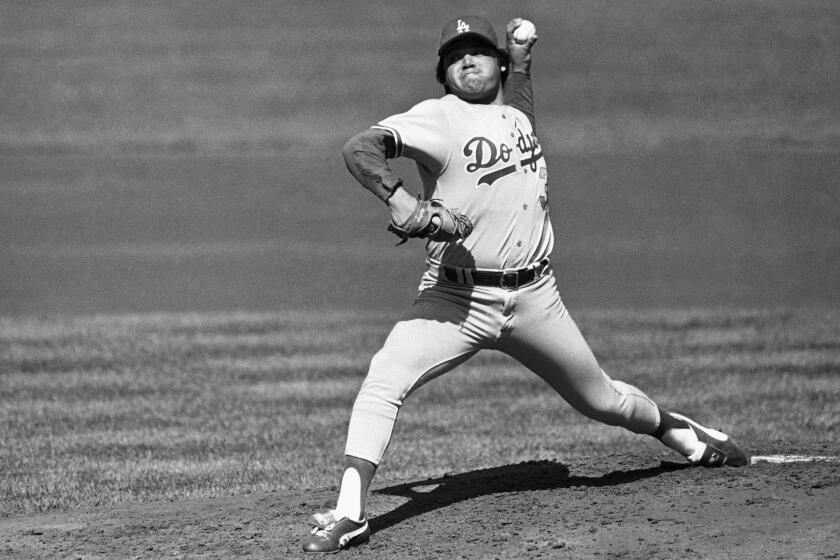Dodgers Dugout: A DH in the NL? Also, Tom Niedenfuer answers your questions

Hi, and welcome to another edition of Dodgers Dugout. My name is Houston Mitchell and how do you feel about a designated hitter being used in the National League during an abbreviated 2020 season?
Are you a true-blue fan?
Get our Dodgers Dugout newsletter for insights, news and much more.
You may occasionally receive promotional content from the Los Angeles Times.
It’s not official yet, but all signs point to the National League using a designated hitter during an abbreviated 2020 season. Now, until it is official, I am not going to weigh in on the topic, but I want to hear from you.
Do you favor the NL using a designated hitter? Click here to vote.
Many of you have emailed in the past to say that if the NL ever adopts a DH rule, that you would stop following baseball. So, I’m interested in how this poll comes out. We’ll talk about it more in the next newsletter, currently scheduled for Tuesday.
Enjoying this newsletter?
Your support helps us deliver the news that matters most. Become a Los Angeles Times subscriber.
Ask Tom Niedenfuer
Throughout the next few weeks, Dodgers Dugout will expand its “Ask...” feature to include former Dodgers. Next up, Tom Niedenfuer.
Niedenfuer is remembered by most Dodgers fans for one pitch that we won’t revisit. And that’s a shame, because he was a very underrated relief pitcher with the team. He was with them for seven seasons (1981-87) and was 30-28 with a 2.76 ERA and 64 saves. He pitched five innings in the 1981 World Series, giving up no earned runs and only three hits. For the Dodgers, he is 24th all-time in games pitched (310) and 11th in saves.
James Winston of Riverside asks: Tom, you were a teammate of Jay Johnstone, who had a reputation for being funny and a prankster. Did he ever get you with a good joke? Or do you have a funniest moment you can recall with him?
Tom: We had a lot of pranksters. Jay Johnstone, Rick Monday and Jerry Reuss, and you can include Tommy Lasorda in that group. But Jay didn’t really get me. I think he was afraid of my 6-foot-5, 235-pound frame. But the best prank I saw on the Dodgers involved Reuss.
I was pitching in the eighth inning one game, and Frank Pulli was the home plate umpire. I was pitching and unbeknownst to me, somehow Reuss had slipped a ball into the umpire’s ball bag that was inscribed, “Dear Frank, May God bless you! Tommy Lasorda.” Pulli never looked at the ball and tossed it to me to use. Every ball feels different, and this one certainly did, so I looked down and saw the inscription. I look over in the dugout and I see Reuss laughing. So I use it for a couple of pitches and it gets fouled back into the stands, right into the section reserved for Dodger family members.
I don’t think much about it after that, but when I get to the ballpark the next day, Lasorda calls me into the office. He says, “Hey, you aren’t going to believe this, but my wife was at the game last night with a friend of ours named Frank. You’re pitching, and a ball gets fouled right to him. He picks it up and it says, ‘Dear Frank, May God bless you! Tommy Lasorda.’ What do you know about this?”
And I said “Tommy, I don’t know a thing but you might want to check with your 6-foot-5 starting pitcher.”
What are the odds of that happening? It may be the best prank few people have ever heard of.
Isaac Dixon of Portland asks: Who was the toughest out you faced year in and year out?
Tom: Well, relief pitchers don’t face the same batters as often as starting pitchers do, so that’s a tough question. We usually come in and face a batter once, maybe twice in a series, and only a couple of times a season. But I’ll give you my worst three, in reverse order:
3. Bo Jackson absolutely wore me out. He was four for eight against me with three home runs.
2. Mike Schmidt. He was five for eight against me. Just one home run though.
1. Without a doubt, Tim Raines. The problem everyone had with him is he had a very small strike zone, and you didn’t want to walk him because then he would steal second and probably third. So you made better pitches to him. He was seven for 13 against me.
Scott Walden asks: Thanks for some good memories. It must have been crazy coming up as a 21-year-old with that 1981 team. You had Fernandomania going on and some great pitchers like Reuss, Hooton, Welch, Howe, Forster, Stewart, and Sutcliffe on the team. You were able to contribute to the success and got to play in the World Series as a rookie. Please share some of your memories from that season.
Tom: It was a dream season. I started in double A and got called up after two or three months. Earlier that year, before the season started, they invited me to big league camp. I had never even pitched in the minors, and here I was hanging out with the major leaguers for a while in spring training. And that helped me a lot. My locker was right next to Burt Hooton. When I was in double A, Hooton would send me his shoes because we had the same shoe size. I knew Ron Cey because he went to Washington State, as did I. I played with Ron’s brother, Doug, there.
So, when I got called up mid-season, I knew some of the guys. And we had a very interesting mix that season. You had all these older guys in their early to mid-30s like Garvey, Cey Russell, Lopes, Monday, Reuss, Yeager. And then we had a bunch of young guys. Fernando was 20, Steve Sax was 21, Dave Stewart 24, myself 21, Scioscia 22. And the veterans welcomed us all, which was a big key to that season.
The big memory was my first game. I struck out Bob Horner on three pitches. I was thinking how great that was when Dale Murphy hit my next pitch off the left-center field wall for a double. That brought me back to reality.
And I pitched the next game too, and got the victory against a Hall of Famer, Gaylord Perry, who was 42. Twice my age.
And then the postseason. I pitched three scoreless innings in Game 1 of the World Series. But here’s what was great about that: The next day, I’m walking on the field with Bob Welch when Lou Piniella of the Yankees says “Hey kid, get over here.” I was trying to remember if I had knocked him down or anything the night before when he said “I just wanted to tell you how great you pitched and how composed you were as a 21-year-old last night.” That was really cool to get such a compliment from an opponent during a World Series, especially someone as good as Piniella.
Of course, the biggest thrill of all was winning Game 6. Because it was so neat to see the guys who had lost to the Yankees in 1977 and 1978 get that monkey off their back.
John L. Borovicka asks: In 1980, you were pitching for Washington State. A year later, you were throwing three innings in the first game of the World Series at Yankee Stadium. How hard was that adjustment to joining such a veteran team, and which players took you under their wings early on?
Tom: Without a doubt, Terry Forster taught me the most. I had been a starter almost my entire baseball career. He taught me how to warm up, how to know when Tommy was going to use you and to make those last six bullpen pitches count. He basically taught me how to be a reliever. He moved me into his house when I first came up until I could get my feet wet. We thought of him as an old guy on the team, because he had been around awhile, but he was only 29.
Also, the Dodgers had a dress code, and being 21 and fresh out of double-A San Antonio, I didn’t exactly have a ton of suits and ties, so Terry loaned me some of his stuff because we were about the same size.
Heather Hudson asks: I ask this with no disrespect intended at all, but as a mom of two boys who play baseball: When they have a tough defeat, what’s the best advice I can give them to move on from it?
Tom: I don’t know how old your kids are, but here’s how I always looked at it. A reliever is like a kicker in football. No one ever notices you until you make a mistake. In any competition you just have to realize that there always be a winner and a loser. That’s just the way it works and you have to try to get not too high or too low.
Bottom line: The manager or coach has to have the belief that you are good enough to be out there when the game is on the line. If he or she didn’t, you wouldn’t be out there for those tough defeats. That is a great compliment and you should focus on that.
Steve Maxwell asks: You went from a Dodgers team that was in contention almost every year, to the Baltimore Orioles, who weren’t that good then. What was that transition like and is there a particular memory from your Orioles days you can share with us? (Note: The Dodgers traded Niedenfuer to the Orioles on May 22, 1987 for outfielder John Shelby and pitcher Brad Havens.)
Tom: Well, I’d only been with the Dodgers, so my initial reaction was shock. And the next shock when I walked into Baltimore’s Memorial Stadium and noticed it was 309 down the line. It was 335 down the line at Dodger Stadium.
The tough part of the AL is the DH. It’s so different. In the NL, the 7-8-9 hitters were usually an easy inning. But in the AL you are facing Don Baylor or Paul Molitor instead of the pitcher.
And it was really one of the only times I wasn’t on a good team. And it was worse in 1988, when we started out 0-21. But the Orioles were a class organization. And I got to play with two first-class pros and Hall of Famers in Eddie Murray and Cal Ripken Jr. They showed our young players the right way to do things. They were great leaders on a bad team.
And to show what great fans the Orioles had: After our 0-21 start to the season, we won in Minnesota. We played the next day in Baltimore, and the game was sold out.
Rose Thomas asks: Why don’t we ever see you at the Dodgers’ old-timers games?
Tom: Because they’ve never asked. And I get it, they want their biggest names there and the players who live closer (note: Niedenfuer lives in Florida). But I’d love to attend if they ever ask me.
Ask Ross Porter
Former Dodgers broadcaster Ross Porter is back for another season of “Ask Ross Porter.” We have a new email address this season for it. Ross will have access to this email address and will get your questions without me having to forward them. So, if you have a message (like thanking him for his years as a broadcaster) and not a question, feel free to let him know. Send your question or comment to [email protected].
Ross: When the Baseball Winter Meetings are held in December, it will be the first time since 2015 the “Golden Days” committee will decide whether to induct stars from 1950-1969 into the Hall of Fame. A historical overview committee of 10 to 12 will have placed 10 candidates on the ballot. The voting 16 will have at least eight Hall of Famers, with the others executives and media. Each can vote for four men. To earn a cherished spot at Cooperstown, a player must receive 12 of the 16 votes.
Bob Shuba of Dover, Delaware asks: It is an injustice Gil Hodges is not in the Hall of Fame. He hit at least 20 home runs for the Dodgers for 11 straight years and drove in 100 runs seven consecutive seasons. How close has he come?
Ross: Hodges missed by three votes in 2011. Bob, he is one of only four players ever to receive 60% of the vote by the writers one year and never be elected. Curt Schilling, Roger Clemens and Barry Bonds are the others. Last year, Schilling missed by 20 votes, Clemens by 56, and Bonds 57.
Allan Jodkowitz asks: Ross, is there a possibility Maury Wills can still get in the Hall of Fame?
Ross: I hope so, Allan. In the last “Golden Days” vote in 2015, Maury missed by three votes, Dick Allen and Tony Oliva each needed only one more and Jim Kaat two. Hodges drew three or fewer votes out of 16. The great sports columnist Jim Murray once wrote, “If Maury Wills doesn’t belong in the Hall of Fame, Babe Ruth doesn’t. He did the same thing Ruth did — change a national pastime.”
My thanks to Robert Schweppe, Tim Mead and Jim Gates for their contributions to our “Golden Days” information. The next vote after this one is in 2025.
I also want to recognize Fred Anschultz for pointing out that Don Drysdale set the major league record with his sixth straight shutout the night Robert Kennedy was shot, and it was not the consecutive scoreless inning mark.
Paul Goodwin of Los Angeles asks: I remember Vinny telling that story about Willie Mays catching Bobby Morgan‘s drive. The warning track had gravel on it, so Mays was sliding on gravel. Vin would tell his stories about games in Brooklyn. It always seemed completely amazing that a catch by Adrian Gonzalez would remind him of a catch by Gil Hodges. Would they simply emerge from his memory? I truly miss you on the air and hope you are staying safe.
Ross: Thanks, Paul, for your kind comments. Vin’s love of the game and his recollection of past plays were made because of his instant recall ability. There was no advance preparation. Update on Vin’s recovery from a fall just over three weeks ago: Improved with less pain and feeling better.
Steven Kresco of Westlake Village asks: When you were announcing for the Dodgers, did you travel to every away game on the team jet?
Ross: Yes, I did for 28 years except to Anaheim and San Diego, when we drove. We never had to go through an airport terminal as a bus drove on the tarmac to our chartered plane when we left a city and arrived at another where a bus picked us up and took us to a hotel.
And finally
Another Dodgers’ zoom party, featuring Joe Davis, Alanna Rizzo, Dave Roberts, Mookie Betts, Eric Gagne, Justin Turner and more. Watch it here.
Until next time...
Have a comment or something you’d like to see in a future Dodgers newsletter? Email me at [email protected], and follow me on Twitter at @latimeshouston. To get this newsletter in your inbox, click here.
Are you a true-blue fan?
Get our Dodgers Dugout newsletter for insights, news and much more.
You may occasionally receive promotional content from the Los Angeles Times.




